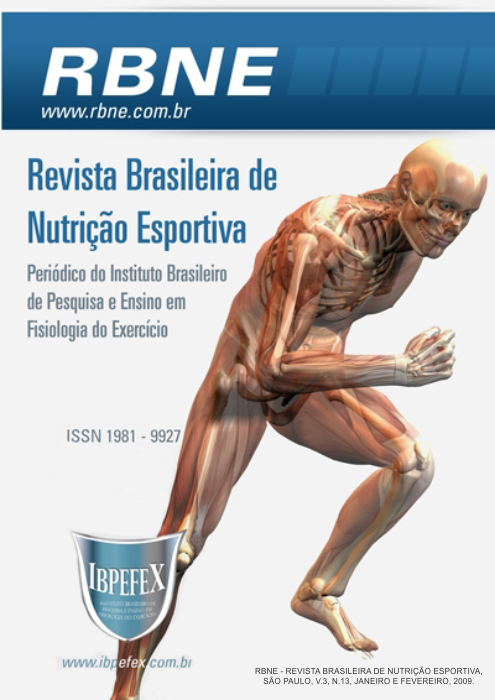Use of alimentary supplements in gymnastics academies
Abstract
This study examined the consumption of food supplements for students in fitness centers in São Paulo, simultaneously the practice of physical exercises, assessing the user profile and their motivations through field research. The population of the study was composed for frequent adores of three different academies of gymnastics, Academy Olympia Gym, Master Academy 24h and Runner, two of average transport and one of great, in relation to the number of pupils and infrastructure. The diadem band of the individuals for the fulfilling of the form understood individuals of 15 the 62 years of age, totalizing 126 participants. It was observed that 103 individuals (82%) had level of superior escolaridade (complete or not). Of these, 87 (69%) had made use of alimentary supplements, mainly protein, creatina and carbohydrates. 78 (62%) belonged to masculine sort and 48 (38%) to the feminine one. Amongst the users in the band of 15 the 27 years, 28.6% were represented by men and 9.5% of women, of the total of 86 users. It followed it 28-38 band years with 14.3% of men and 4% of the women and between 50-62 years, only 1.6% of men are consuming. 85.7% (108 individuals) had affirmed to have concluded or to be attending a course Superior Education and 14.3% (18) they said to possess Average Education. It was observed higher consumption by the public man, especially younger people, mainly to gain muscle mass.
References
Araújo, A.C.; Soares, M.; Gonçalves, Y.N. Perfil de utilização de repositores protéicos nas academias de Belém, Pará. Revista Nutrição. Pontifícia Universidade Católica de Campinas. Campinas, SP. Vol.12. Núm. 1. Jan/abr. 1999. pp 81-89.
Barret, S. Consumer health: a guide to intelligent decisions. 6th. Madison: Brown & Benchmark Publishers. 1997.
Cowart, V.S. Dietary supplements: alternatives to anabolic steroids? Physician Sportsmed. Vol. 20. 1992. pp.189-198.
Eliason, B.C.; Kruger, J.; Mark, D.; Rasmann, D.N. Dietary supplement users: demographics, product use, and medical system interaction. Board Family Practice. Vol. 10. 1997.pp. 265-271.
Grunewald, K.K.; Bailey, R.S. Commercially marketed supplements for bodybuilding athletes. Sports Med. Vol. 15. 1993. pp. 90-103.
Lollo, Pablo Christiano B.; Tavares, Maria da Consolação G.; Cunha F. In XIX Congresso Internacional De Educação Física. 2004. Foz do Iguaçu, PR. Brasil. In <http://www.efdeportes.com/efd76/supl.htm>. Acesso em 07/01/2009
Pereira, Raquel F; Lajolo, Franco M.; Hirschbruch, Marcia D. Consumo de suplementos por alunos de academias de ginástica em São Paulo. Revista Nutrição. Pontifícia Universidade Católica de Campinas. Campinas. SP. Vol. 16. Nº 3. Jul/Set. 2003.
Philen, R.M.; Ortiz, D.I.; Auerbach, S.B.; Falk, H. Survey of advertising for nutritional supplements in health and bodybuilding magazines. J. Am. Diet Assoc. n. 268. 1992. pp. 1008-11.
Position of the American Dietetic Association. Functional foods. J. Am. Diet Assoc. Vol. 99. 1999. pp.1278-85.
Position of the American Dietetic Association. Vitamin and mineral supplementation. Am. Diet Assoc. Vol. 96. 1996. pp. 73-87.
Tesseroli, Maristela. Consumo excessivo de suplementos. Revista Metrópole. Campinas, SP. Janeiro de 2005. Disponível em: http//:unicamp.br/unicamp/canal_ aberto/ clipping/maio2005/clipping050503_correiopop.html>. Acesso em 07/01/2009.
Authors who publish in this journal agree to the following terms:
- Authors retain the copyright and grant the journal the right of first publication, with work simultaneously licensed under the Creative Commons Attribution License BY-NC which allows the sharing of the work with acknowledgment of the authorship of the work and initial publication in this journal.
- Authors are authorized to enter into additional contracts separately for non-exclusive distribution of the version of the work published in this journal (eg, publishing in institutional repository or book chapter), with acknowledgment of authorship and initial publication in this journal.
- Authors are allowed and encouraged to post and distribute their work online (eg, in institutional repositories or on their personal page) at any point before or during the editorial process, as this can bring about productive change as well as increase impact and impact. citation of published work (See The Effect of Free Access).






